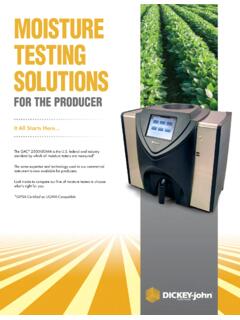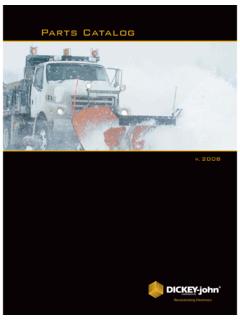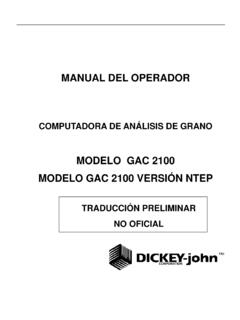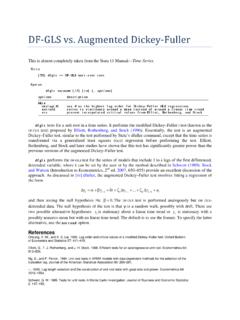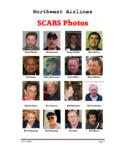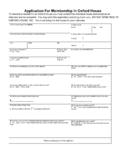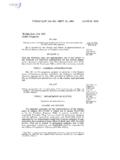Transcription of Programming, Operating & Basic Repair Techniques - …
1 TRAINING MANUAL. dickey -john TRAINING. CONFERENCE HANDBOOK. programming , Operating &. Basic Repair Techniques CCS100 Control System CMS100 Monitoring System CCS100 & CMS100. 11001-1392-200704 1. TRAINING MANUAL. CCS100 & CMS100. 2 11001-1392-200704. TRAINING MANUAL. Table of Contents Course Objectives ..7. Lesson Materials ..9. Basic Functions of CCS/CMS Systems ..11. Overview of System 13. Basic Modes of Operation .. 19. Developing Constants Granular System .. 29. Developing Constants Liquid System .. 33. Developing Constants Anhydrous Ammonia .. 41. Technical Reference Material .. 47. Commonly Asked Questions .. 59. Granular Spreader Constant References .. 67. Liquid Sprayer Constant References .. 68. Anhydrous Ammonia Constant References .. 69. Cable Repair Procedures.
2 70. Troubleshooting Sensors .. 74. CCS100 & CMS100. 11001-1392-200704 3. TRAINING MANUAL. CCS100 & CMS100. 4 11001-1392-200704. TRAINING MANUAL. WELCOME. dickey -john welcomes the opportunity to present this material. It is our pleasure to provide training on this equipment and to answer any concerns or questions. With this exchange of information, we can together perform our jobs better. The main function of this workshop is to allow you to become more acquainted with these products. It is always a pleasure to serve you our valued customers. dickey -john believes that the more understanding its customer's have of a prod- uct, the more useful that product becomes. CCS100 & CMS100. 11001-1392-200704 5. TRAINING MANUAL. CCS100 & CMS100. 6 11001-1392-200704. TRAINING MANUAL.
3 Course Objectives The CCS/CMS100 system is an extremely versatile unit that can be easily programmed to automatically control the application rates of given products regardless of changes in vehicle ground speed and also monitor a number of field conditions. The major purpose of this course is to train you in the operation, programming , and the performing of minor troubleshooting procedures on the CCS/CMS100 Control system. When you have completed this course, you will have learned how to: Explain the Basic function and use of each system. Explain the differences between and the functions of both units. Define sensors required and explain the purpose of each. Define the use of each touchswitch on the front panel. Enter the different modes and explain the function of each.
4 Read and explain the meanings of displayed data. State the meaning of error messages and how to correct errors. Understand how to use the cabling diagrams. Perform Basic Repair by using simple troubleshooting charts. Secure aid in the event of a serious problem. CCS100 & CMS100. 11001-1392-200704 7. TRAINING MANUAL. CCS100 & CMS100. 8 11001-1392-200704. TRAINING MANUAL. Lesson Materials This manual is divided into two separate parts. Part I contains instructional ma- terials to explain Basic overall concepts and Operating principles of the systems. Part II contains more detailed reference materials which elaborate certain sub- PART 1 jects with more in-depth information. Other information is for reference material use later. Topics included in this Part are: Lesson 1: Basic Function of CCS/CMS Systems.
5 Lesson 2: Overview of System Layout. Lesson 3: Basic Modes of Operation. Lesson 4: Developing Constants Granular System. Lesson 5: Developing Constants Liquid System. Lesson 6: Developing Constants Anhydrous Ammonia. Lesson 7: Common Operator Problems Encountered. CCS100 & CMS100. 11001-1392-200704 9. TRAINING MANUAL. CCS100 & CMS100. 10 11001-1392-200704. TRAINING MANUAL. Basic Functions of CCS/CMS Systems Topics: 1. Overall System Function LESSON 1 2. 3. Sensors Required and Options Available System Configurations The CCS100 and CMS100 consoles units are both microprocessor controlled containing similar circuitry but performing different functions. The major difference The CCS and CMS units are often between the units is designed into the internal program of the microprocessor.
6 Connected together into one control The operator must complete the programming process in the field by entering a system. Sensors develop status signals few constants upon which the microprocessor acts to calculate its performance. which are delivered through cabling to Once the two units are properly programmed, the system (both units) automati- the two consoles for processing and cally controls (CCS100) the application rate of the product and also monitors monitoring. Output drive signals from (CMS100) speed and area information. Automatic application starts when the the CCS100 control the application vehicle begins to move, varies as ground speed changes and stops when the rate of the product. Input signals to the CMS100 monitor Operating conditions. vehicle ceases moving.
7 The product application rate is controlled as long as the ground speed is within the specified speed range of the system. In this lesson, you will learn how to: Function of the CCS Console Define the Basic function of the CCS unit. The CCS100 Custom Control System is a versatile device that can be installed Define the Basic function of as either a granular spreader, NH3 or liquid system. It can then be programmed the CMS unit. to automatically control the application rate of a given product. That rate of ap- Use both units together in plication remains constant throughout the field regardless of any changes in the one system vehicle ground speed. Configure a Basic granular spreader control system. Function of the CMS Console Configure a liquid sprayer control system. The CMS100 Custom Monitoring System is a monitoring device that is usually in- Configure an anhydrous stalled as a companion unit to the CCS100 system for displaying additional infor- ammonia control system.
8 Mation. The unit utilizes the same sensor signals as the CCS100 console to de- velop status readouts. The additional information displayed is for ground speed, field area, total area, area per hour, distance (footage counter), field product, total product, product level, application rate, product sensor output, and an auxiliary sensor output. The CMS100 unit normally connects to a control system's sensors through an addition of a Y cable which parallels the sensor input signals. The CMS100 also can operate as a stand alone unit to monitor speed/area func- tions provided the CCS100 main harness and ground speed sensor are installed on the vehicle. The CMS100 console can be used alone to monitor speed/area provided the harness and sensors are available. Three Basic Configurations The two console units are installed in one of three Basic configurations.
9 The CMS100 unit is connected to each system via a Y-cable. CCS100 & CMS100. 11001-1392-200704 11. TRAINING MANUAL. 1. A Granular Spreader Control System consists of five major compo- nents; (1) control console(s) with a switch module, (2) a hydraulic control valve and vale driver, (3) a ground speed sensor, (4) an application rate sensor, and (5) an optional hopper level sensor or fan sensor. The two consoles are installed within the vehicle cab. The hydraulic control vale is installed in the hydraulic line to the conveyor motor to regulate the motor rate. The ground speed sensor senses the miles per hour (MPH) speed of the vehicle. One of three types of ground speed sensors is installed;. (1) in-line speedometer drive sensor, (2) magnetic wheel sensor, or (3). radar velocity sensor.
10 The application rate sensor is installed on a shaft that rotates at a proportional rate to the conveyor speed. Putting It Together: The CCS100 console controls the 2. A Liquid Sprayer Control System consists of only four major components;. application rate and the CMS100 (1) control console(s) with a switch module, (2) liquid control valve, (3). console monitors speed/area func- ground speed sensor, and (4) a pressure sensor. The CCS100 console tions. compares these input signals to a desired application rate as pro- The two consoles use signals from grammed by the operator and develops a proper output drive signal to the same sensors and are connect- the servo control valve to maintain uniform application rate. ed in parallel to share those signals. The CCS100 console can be used 3.
